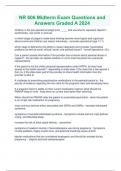NR 606 Midterm Exam Questions and Answers Graded A 2024 Children in the pre -operational stage think _____ and use what to represent objects? - symbolically, use words or pictures in which stage of piaget's model does thinking become more logical and organized about events and children can reason inductively - concrete operational (age 7 -11) which stage is defined by the ability to reason abstractly and consider hypothetical problems as well as moral, ethical, social, and political issues? - formal operations (12+) Can a parent access information if the provider has concerns about parental abuse or neglect? - the provider can decide whether or not to treat the parent as a personal representative If the parent is not the child's personal representative under HIPPA, do they have access to the health records? - depending on state laws - if the state has a law against it then no, if the state does permit the provider to share health information then th e provider is able to A challenge to prescribing psychoactive medications in the perinatal period is - the paucity of evidence regarding the true risks for the pregnant client and developing fetus If a pregnant client is stable on their current medication regimen what should the PMHNP keep in mind - keep them on current med rather than switching When should the PMHNP refer the patient to a perinatal psychiatrist - when the patient is on a high -risk medication for pregnancy most common adverse effect associated with SSRIs and SNRIs - neonatal withdrawal syndrome symptoms of neonatal withdrawal syndrome - Symptoms include tremors, high -pitched crying, and disturbed sleep increase the risk of atrial septal defects. - paroextine symptoms of newborn toxicity r/t benzodiazepine use during pregnancy - Symptoms include sedation, floppy muscle tone, and potential breathing issues at birth bipolar medications that are considered teratogenic and should be avoided during pregnancy. - valproic acid and carbamazepine Atypical antipsychotics that increase risk of gestational diabetes and large for gestational age infants - olanzapine and quetiapine has also been found to increase the risk of musculoskeletal malformations in infants - olanzapine the most used antipsychotics during pregnancy - risperidone and quetiapine medications that are safe for breast feeding - SSRIs, benzos, valproic acid, quetiapine medications that are safe for bottle feeding - lithium, lamotrigine, clozapine smoking - related pregnancy complications - ectopic pregnancy, placental abruption, placenta previa, fetal mortality, and stillbirth, as well as preterm birth and low birth weight infants Smoking -related effects on neonates include - sudden infant death syndrome and birth malformations such as oral clefts and neural tube defects smoking effects on infants, children, and adolescents include - asthma, cognitive impairment, lower respiratory illness, attention deficit hyperactivity disorder (ADHD), and central nervous system tumors Health problems associated with alcohol use disorder include - increased risk for miscarriage, stillbirth, congenital anomalies, low birth weight, small for gestational age, and preterm delivery risk of using cannabis during the perinatal period - including preterm labor, low birth weight and small for gestational age deliveries, and adverse effects on fetal and adolescent brain growth, executive functioning skills, behavioral problems, and academ ic achievement Cocaine use during pregnancy is linked with poor pregnancy -related outcomes including - premature rupture of membranes, placental abruption, preterm birth, low birth weight, and small for gestational age deliveries, as well as long -term effects in children and adolescents including lower short -term memory, child and adolescent delinquent behavior, earlier age of sexual activity, and substance use complications of opioid use during the perinatal period - eclampsia, heart attack or heart failure, and sepsis. Infants experience significant adverse effects, including neonatal abstinence syndrome, third trimester bleeding and mortality, postnatal growth deficiency, microcephaly, neurobehavioral problems, and sudden infant death syndrome includes policies, regulations, or laws that intentionally or unintentionally lead to discrimination - structural stigma




